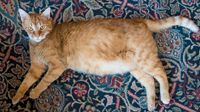Hot Literature: Could being overweight be beneficial for cats with heart failure?
Does the obesity paradox in people occur in cats as well?
Known as the obesity paradox, obesity in people has been shown to have a direct and positive effect on survival time in patients with heart failure. Conversely, weight loss in these patients has a documented negative effect. This has been demonstrated to be true in dogs as well, and maintaining optimal weight and preventing cardiac cachexia in heart failure patients is a key goal of care. But can obesity in cats with heart failure improve survival time?
Cardiomyopathies are common in cats, and since an estimated 25% to 52% of the cat population is overweight or obese, many cats with cardiac disease are also obese. A recently published study compared the survival times of normal and underweight cats with heart failure with those that were overweight or obese.

Joel Sartore/Getty Images
Cases included in this study were selected from a computer database of cats seen for cardiomyopathy and heart failure at Tufts Cummings School of Veterinary Medicine between 2007 and 2009. The cats had initial diagnoses of congestive heart failure when they were over 1 year of age and an International Small Animal Cardiac Health Council (ISACHC) classification of II, IIIa, or IIIb. Cats with hyperthyroidism or congenital heart diseases were excluded. The medical records from 101 feline patients were reviewed, and the data on their underlying cardiac disease, body condition, initial weight and weight changes over time, survival time, and cause of death or euthanasia were analyzed. The median age of cats was 10 years but ranged from 2 to more than 18 years of age. All of the patients were neutered; 70 were male and 31 were female.
Not surprisingly, hypertrophic cardiomyopathy was the most common underlying cardiac disease. Thirty-two cats were initially classified as underweight, 26 were in the normal category, and 34 were in the overweight category. Body weight did not differ significantly based on ISACHC rating, but anorexia was more likely in those with more severe heart disease (class IIIb).
Many of the cats died or were euthanized at the time of the initial visit, but 68 were discharged from the hospital. Excluding those that died within the first 24 hours, the survival time was 201 days. Of those cats discharged, 22 lost weight and another 22 gained weight over the course of their disease. The remainder had negligible weight changes. The weight changes were not related to initial disease severity or underlying disease condition. Interestingly, of the cats that lost weight, the loss was significant; 34% of the cats discharged from the hospital lost > 5% of their initial body weight. There were no correlations between survival and initial presenting signs, ISACHC class, medications given, age, sex, serum chemistry profile results, body condition score, or change in body weight. However, survival was linked to initial body weight, with cats with the lowest and highest initial body weights having the shortest survival times compared with cats in the intermediate body weight ranges. Thus, these findings suggest a U-shaped relationship between body weight and survival in cats.
Because the study is a retrospective examination of medical records, there may have been a high degree of variability in the body condition scoring performed by multiple individuals. Additionally, while body weight was adjusted for various fluid accumulations, the weight measurements may have been overestimated both at initial evaluation and at follow-up visits. Many other significant variables could not be eliminated based on this study design. However, unlike studies looking into obesity and weight loss in canine and human cardiac patients, no direct link was seen between weight changes and survival, and there did appear to be a difference based on the level of obesity. The results do suggest that body composition plays an important role in heart failure, and additional research could help optimize management strategies for cats with heart failure.
Finn E, Freeman LM, Rush JE, et al. The relationship between body weight, body condition, and survival in cats with heart failure. J Vet Intern Med 2010;24(6):1369-1374.
For a link to the full text, click here.